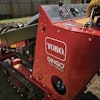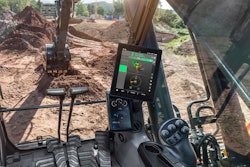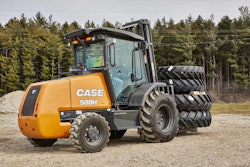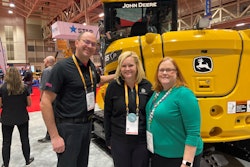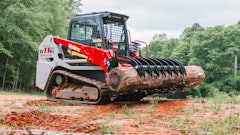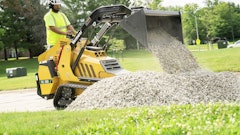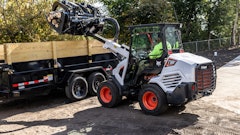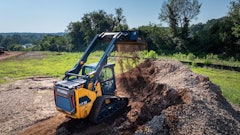
On many jobsites across the U.S., owners and managers continue to encounter an issue that has negatively impacted the construction industry for years: a decline in operator retention. In response, Kevin Coleman, senior product specialist, Caterpillar, advises owners and managers to provide comfortable equipment for their operators. By offering equipment that operators will enjoy using, Coleman believes they’ll be more likely to remain with their employers on a longer-term basis.
 Bobcat's most recent CTLs feature one-piece cab designs, which reduce the likelihood that debris and dirt will enter.Bobcat
Bobcat's most recent CTLs feature one-piece cab designs, which reduce the likelihood that debris and dirt will enter.Bobcat
To enhance operators’ comfort, compact track loader (CTL) manufacturers—like Bobcat Company, Caterpillar, DEVELON North America, Kubota and Wacker Neuson—are ensuring that their CTL cabs are as comfortable as possible. Jacob Sherman, product and dealer marketing manager, DEVELON North America, stresses that CTLs are more comfortable today than they’ve ever been.
“CTLs are staple products on construction sites in the U.S., as operators may spend much of their day using CTLs and attachments,” he said. “With this in mind, larger cabs provide them more comfortable operating areas for long days, which helps create a better work environment. As a result, operators will be more prone to remain loyal to their employers.”
Doug Clark, product manager, compact equipment, Wacker Neuson agrees with Sherman’s sentiment, adding that manufacturers are, consequently, striving to improve operators’ comfort.
“Manufacturers’ focus on operators’ comfort usually begins with their cabs’ designs,” he stressed. “By incorporating additional space, high visibility and a variety of other comforts within their cabs, manufacturers can reduce operators’ fatigue, while increasing their productivity, too.”
Cab Structure & Safety
 To further add to its spaciousness, Kubota's SLV75-3 has a roll-up door that enables its front pillars to be narrow, leading to easy-in and easy-out access.Kubota
To further add to its spaciousness, Kubota's SLV75-3 has a roll-up door that enables its front pillars to be narrow, leading to easy-in and easy-out access.Kubota
“For example, Kubota’s latest CTL introduction, the SVL75-3, is equipped with a one-piece sealed cab that helps prevent debris, dirt, dust and rain from entering the operator space,” Corder stated. “Furthermore, noise levels will simultaneously decrease.”
With increased debris ingress and decreased noise in the cab, operator safety is also increased. Caterpillar’s CTLs feature enclosed cab designs too, each of which is one complete unit. Therefore, every cab is sealed as a unit, ensuring that it doesn’t rely on sealing by either compressing gaskets or foam, as is the case with two-piece cab designs. Moreover, according to Coleman, Caterpillar’s CTLs’ one-piece, enclosed cab designs offer operators a safe, clean and quiet working environment throughout the equipment’s lifespans.
 Caterpillar's CTLs’ one-piece, enclosed cab designs offer operators clean, quiet working environments throughout their entire lifespans. They also provide other creature comforts.Caterpillar
Caterpillar's CTLs’ one-piece, enclosed cab designs offer operators clean, quiet working environments throughout their entire lifespans. They also provide other creature comforts.Caterpillar
“They reduce noises and vibration too, leading to more enjoyable work experiences for operators, as a whole,” said Zima. “In turn, operators can focus more on their job tasks, rather than their surrounding environments, resulting in higher productivity.”
Fully Use Compact Spaces & Enhance Visibility
Regardless of how large CTLs’ cabs become, they’ll only provide operators with so much space. After all, CTLs are compact machines, resulting in compactness in virtually every aspect of them, including their cabs. Yet, despite their compactness, Clark emphasizes that cabs never have to be cramped as manufacturers must focus on their total floor space. Wacker Neuson's ST27's vertical arm linkage is properly aligned to its cab posts, enabling operators to maximize their rear visibility.Wacker Neuson
Wacker Neuson's ST27's vertical arm linkage is properly aligned to its cab posts, enabling operators to maximize their rear visibility.Wacker Neuson
“Typically, operators aren’t small people, so if, let’s assume, they have size 11 feet and are wearing PPE boots that have dirt or mud built up on them, they won’t want a small foot well or a raised partition that comprises most of their foot room,” Clark explained. “Considering operators’ average sizes, Wacker Neuson has designed a wide foot well that has plenty of room, as it extends out below each cab’s door, enabling operators to stretch their legs.”
At the same time, to ensure that operators have as much space as possible, Kubota’s SVL75-3 offers a wide cab entrance, via a sliding front door, which can be opened despite a bucket’s or loader arms’ positioning. Following suit with its previously released CTLs, the SVL75-3 provides spaciousness too.
“Sometimes, manufacturers will decrease space while adding technology to their cabs, leading to a more claustrophobic working environment,” Corder said. “However, Kubota started with a roomy cab and left it that way.”
He continued, “To further add to its spaciousness, the SLV75-3’s roll-up door enables its front pillars to be narrow, resulting in easy-in and easy-out access while ensuring [that] its windows remain large as well … creating a bright, airy feel.”
 To ensure operators have as much space as possible, Kubota’s SVL75-3 offers a wide cab entrance, via a sliding front door.Kubota
To ensure operators have as much space as possible, Kubota’s SVL75-3 offers a wide cab entrance, via a sliding front door.Kubota
For instance, Caterpillar’s CTLs have, as defined by the manufacturer, “heads-up displays/monitors” that enable operators to view their rearview camera images, while simultaneously using their standard rearview mirror. As a result, they’ll have consistently high rear visibility—without ever having to awkwardly turn their necks whenever they reverse their CTLs. In addition, each of the manufacturer’s recently released 255 and 265 models feature an Advanced Touchscreen Monitor that supports its optional side-view camera, leading to more comprehensive sight around both CTLs, particularly in the areas located behind their tracks.
“In doing so, operators can easily see critical areas for their everyday work tasks, such as the front, rear and sides of their tracks, their rear machine corners, the areas behind their CTLs and their bucket’s cutting edge, along with its sides,” Coleman said. “By having excellent sight lines to these areas, operators will be more comfortable and productive.”
 Caterpillar’s CTLs have heads-up displays/monitors that allow operators to see their rearview camera images while using their standard rearview mirror at the same time.Caterpillar
Caterpillar’s CTLs have heads-up displays/monitors that allow operators to see their rearview camera images while using their standard rearview mirror at the same time.Caterpillar
“[It offers] a much better view out of the windshield, and [operators] can see much better out of the front,” he stated. “Its display [gives] 270 degrees of additional views on the side and back, rather than just the rear.”
To reduce operators’ strain and enhance their peripheral visibility, each of Bobcat Company’s most recent CTL cabs features a clear-side enclosure. Furthermore, according to Zima, cameras and screens ensure that operators can constantly monitor everything that’s occurring around their CTL without having to injure their necks doing so.
Meanwhile, Kubota’s SVL75-3 features front and rear LED work lights and a large, upper windshield that enhances operators’ visibility. Concurrently, Wacker Neuson’s newest and smallest CTL, the ST27, has taken “360-degree visibility to a new level,” according to Clark.
“Its track frame design allows it to have a lower profile on its loader arm, thereby improving operators’ side visibility,” Clark said.
At the same time, operators’ rear visibility will be maximized as well, as the CTL’s vertical arm linkage is properly aligned to its cab posts.
“[Because of] these features, operators will reduce their back and neck stress, as they won’t have to lean forward to see their CTL’s cutting edge,” he continued. “They also won’t need to strain to look over their shoulder to see their CTL’s side and rear. Not to mention, they’ll diminish any fatigue related to poor visibility, too.”
Control Movements, Acquire Information Concisely
This March, DEVELON North America previewed its first-ever CTL at CONEXPO-CON/AGG. Set to be released in 2024, the CTL, known as the DTL35, will offer a variety of other features, related to comfort, aside from spacious cabs and high visibility. For instance, it will enable operators to control its movements, lift arm and attachments completely with their hands. While doing so, operators can change each movement, along with the lift arm and attachment capabilities, according to their ideal patterns. Further, for safety purposes, the DTL35’s front access door features polycarbonate glass, which minimizes the likelihood of damage that would have otherwise led to severe cuts. DEVELON North America's DTL35's operators can change its lift arm and attachment capabilities, according to their ideal patterns.DEVELON
DEVELON North America's DTL35's operators can change its lift arm and attachment capabilities, according to their ideal patterns.DEVELON
“To increase operators’ visibility of their jobsites, the DTL35 will provide an Around View Monitor camera system, along with an 8-inch touchscreen, which they can use to view various angles—behind, in front of and to the sides of their CTL,” Sherman said.
Recently, Kubota added a 7-inch color LCD touch panel (featuring a jog dial), to each of its cabs, enabling effortless visibility. Positioned to the front right of an operator, the touch panel offers access to several functions and key information like a CTL’s auxiliary mode, battery charge, coolant temperature, fuel level and hydraulic oil level. For further user-friendliness, each CTL’s rearview camera is positioned in the same location as the touch panel, according to Corder.
“This touch panel allows operators to receive information clearly and concisely, in a way that novice and experienced operators alike can interpret,” Corder said. “They’ll no longer have to search for buttons, dials and gauges [because] everything will be in a central location right in front of them and at their fingertips.”
He added, “And, speaking of fingertips, the touch panel [can be used] even if operators have their gloves on, allowing them to wear them at all times, especially as temperatures drop during the winter.”
Minimize Fatigue Via Joysticks
Caterpillar’s new 255 and 265 CTL models offer optional joysticks, known as Advanced Joysticks, that provide operators fingertip navigation of their cabs’ monitors (known as advanced monitors, according to Caterpillar). Simultaneously, the joysticks also have audio controls, ensuring that operators never have to move their hands from their joystick to navigate the monitor. For usability purposes, while navigating the monitor, they won’t have to use a jog dial either.
“These low-effort joysticks provide operators [with] maximum control, while requiring minimum fatigue, especially when they have to operate them for long periods of time,” Coleman said.
In addition to offering operators independently adjustable, seat-mounted joystick controls, each of Caterpillar’s CTLs provide optional, heated, high-back, air ride seats. Used in combination with the manufacturer’s adjustable, seat-mounted joystick controls, the air ride seats are comfortable and ergonomic because joysticks can be attached to them. In turn, they’ll move with operators, leading to accurate, effortless control as they travel in rough terrain. If operators prefer, joy sticks can also be adjusted independently of their seats, resulting in various operating positions that enhance their comfort, despite their sizes.
“The 255 and 265 models feature a new seat offering, known as High Comfort, as well,” Coleman explained. “Ventilated and heated, the seat circulates air in each cab through the seat, leading to additional operator comfort.”
Bobcat Company’s CTLs’ joysticks can move in conjunction with cabs’ seats, too. Requiring minimal effort from operators, the joysticks enable them to control all their CTLs’ machine functions solely with their hands, enhancing efficiency and minimizing fatigue. Since each joystick is intuitive, operators can maintain their efficiency as they transition from one attachment and job task to another, according to Zima.
“It was important for Bobcat engineers to also incorporate drift compensation into their CTLs’ joysticks,” he said. “In doing so, they were able to eliminate any left or right pulls that were caused by operators’ work conditions or attachments.”
 Bobcat's latest CTLs diminish noises and vibrations, ensuring operators have more enjoyable work experiences.Bobcat
Bobcat's latest CTLs diminish noises and vibrations, ensuring operators have more enjoyable work experiences.Bobcat
“These settings range from one to three and control the speed responses of CTLs’ levers, pedals and joysticks,” Zima added. “This can be especially helpful to new operators that are learning more about their CTLs or seasoned operators that have specific preferences for their CTLs’ operations.”
For further flexibility, Wacker Neuson’s ST27 features EH joystick controls that allow operators to toggle between ISO and H-Pattern, entirely through a switch that’s located in the cab. Because of the ST27’s 5.7-inch color display, operators can effortlessly adjust their joystick’s sensitivity and their machine response setting, leading to a fully customizable operating experience. According to Clark, because of each of these features, the cab achieves one goal: a decline in fatigue, regardless of operators’ skill levels.
“Since the control patterns can be toggled between ISO and H-Pattern, via a conveniently located switch, operators with different backgrounds, skill levels and operating experiences can efficiently operate the ST27 at their comfort levels, which significantly improves their productivity,” he stated.
Other Innovations That Enhance Productivity
 Caterpillar CTLs feature enclosed cab designs, each of which is one complete unit. As a result, every cab is sealed as a unit, ensuring it won't rely on sealing by compressing gaskets or foam.Caterpillar
Caterpillar CTLs feature enclosed cab designs, each of which is one complete unit. As a result, every cab is sealed as a unit, ensuring it won't rely on sealing by compressing gaskets or foam.Caterpillar
“The 265 has a cell phone holder [too],” said Ford. “If somebody calls, [operators] can see who’s calling and decide if they need to talk or not.”
DEVELON’s Sherman believes such additions separate some CTLs from others on the market.
“Additions like Bluetooth technology are important for operators today,” he said. “With this in mind, Bluetooth audio will be featured on the DTL35, enabling operators to conduct hands-free phone conversations and listen to their favorite music or podcasts while they work.”
Fully understanding the value of Bluetooth as well, Kubota’s closed cab models include integrated Bluetooth radio, which provides operators with seamless streaming, while also allowing them to conduct hands-free calling, according to Corder.
“For further hands-free operation, Kubota’s SVL75-3 features a keyless engine start too, which can save up to 51 user passcodes,” he stated.
As an example of its commitment to technology, Caterpillar’s CTL cabs offer the following innovations as well:
- Dual direction self-leveling. According to Coleman, this system can electronically and automatically level each CTL’s loader linkage as its lift arms are raised and lowered. Therefore, operators can retain their materials and control their loads as optimally as possible while remaining seated in their cabs.
- Return-to-dig. “This feature enables operators to fully lower their CTLs’ loader arms and return [the] attachment to a pre-selected angle with the touch of a button,” Coleman said. “Consequently, operators can focus on other aspects of their work cycles rather than managing loader functions, resulting in peak productivity.”
- Work tool positioner. Finally, Caterpillar’s CTLs allow operators to select and set a desired working angle (tilt position) for any attachment, which can then be returned to a preselected angle—simply by touching a button in their cabs—leading to more control whenever a repetitive attachment angle is desired for consistency purposes.
While reflecting on recent cab innovations, Sherman believes such technology will continue to be released by manufacturers worldwide.
“The more cab-based technology that manufacturers implement to ensure [that] operators’ jobs are easier, the better,” Sherman emphasized.
Zima agrees, adding that manufacturers should be equally committed to enhancing operators’ productivity and performance as they improve their CTLs’ cabs.
“Not only do we want operators to feel comfortable in their cabs, but we also want [the] cabs’ latest features to help improve their job performance,” he said. “Ultimately, these advancements translate to enhanced jobsite efficiency and, in turn, positive results for their employers’ bottom lines.”


